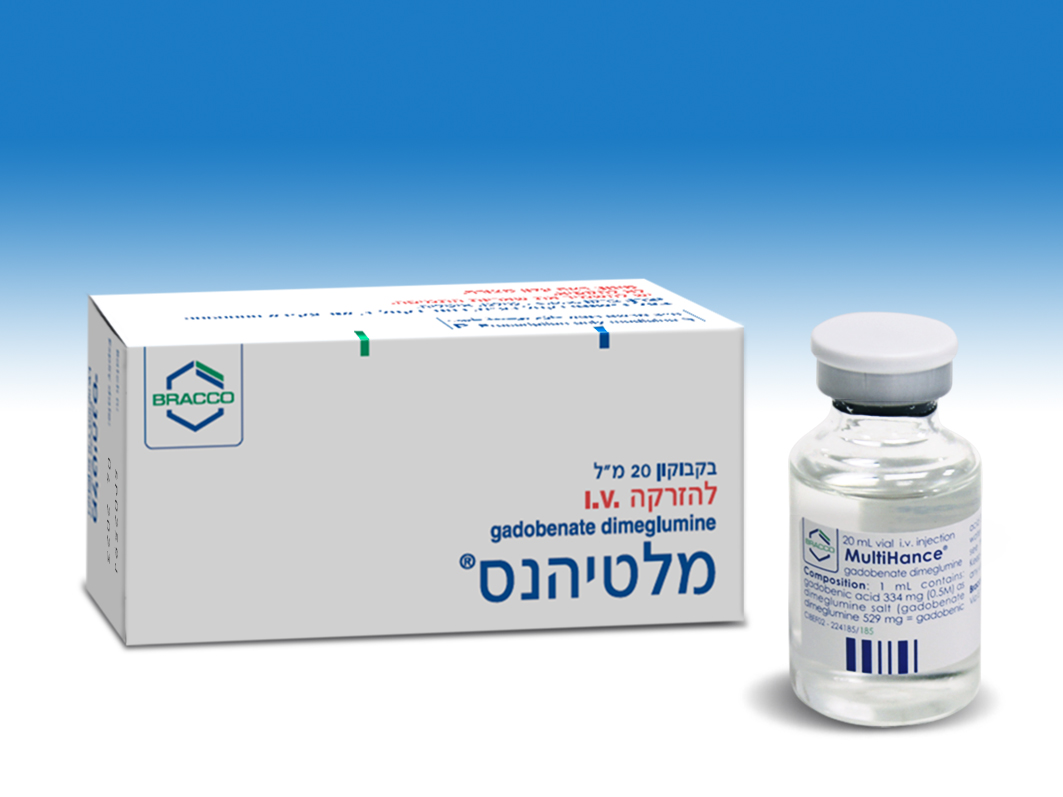Quest for the right Drug

מלטיהנס MULTIHANCE (GADOBENIC ACID AS DIMEGLUMINE SALT)
תרופה במרשם
תרופה בסל
נרקוטיקה
ציטוטוקסיקה
צורת מתן:
תוך-ורידי : I.V
צורת מינון:
תמיסה להזרקה : SOLUTION FOR INJECTION
עלון לרופא
מינוניםPosology התוויות
Indications תופעות לוואי
Adverse reactions התוויות נגד
Contraindications אינטראקציות
Interactions מינון יתר
Overdose הריון/הנקה
Pregnancy & Lactation אוכלוסיות מיוחדות
Special populations תכונות פרמקולוגיות
Pharmacological properties מידע רוקחי
Pharmaceutical particulars אזהרת שימוש
Special Warning עלון לרופא
Physicians Leaflet
Posology : מינונים
4.2 Posology and Method of Administration The lowest dose that provides sufficient enhancement for diagnostic purposes should be used. MRI of the liver: the recommended dose of MultiHance injection in adult patients is 0.05 mmol/kg body weight. This corresponds to 0.1 mL/kg of the 0.5 M solution. MRI of the brain and spine: the recommended dose of MultiHance injection in adult and in paediatric patients greater than 2 years of age is 0.1 mmol/kg body weight. This corresponds to 0.2 mL/kg of the 0.5 M solution. MRA: the recommended dose of MultiHance injection in adult patients is 0.1 mmol/kg body weight. This corresponds to 0.2 mL/kg of the 0.5 M solution. MRI of the breast: the recommended dose of MultiHance in adult patients is 0.1 mmol/kg body weight. This corresponds to 0.2 mL/kg of the 0.5 M solution. Method of administration MultiHance should be drawn up into the syringe immediately before use and should not be diluted. Any unused product should be discarded and not be used for other MRI examinations. To minimise the potential risks of soft tissue extravasation of MultiHance, it is important to ensure that the i.v. needle or cannula is correctly inserted into a vein. The product should be administered intravenously either as a bolus or slow injection (10 mL/min.), see table for post-contrast imaging acquisition. The injection should be followed by a flush of sodium chloride 9 mg/ml (0.9%) solution for injection. Post-contrast imaging acquisition: Dynamic imaging: Immediately following bolus injection. Liver Delayed imaging: between 40 and 120 minutes following the injection, depending on the individual imaging needs. Brain and up to 60 minutes after the administration. Spine MRA immediately after the administration, with scan delay calculated on the basis of test bolus or automatic bolus detection technique. If an automatic contrast detection pulse sequence is not used for bolus timing, then a test bolus injection ≤2 mL of the agent should be used to calculate the appropriate scan delay. Breast A T1-weighted, gradient-echo sequence with a time resolution of 2 minutes or less should be acquired before contrast injection and repeated several times over a period of 5 to 8 min after a rapid intravenous contrast bolus injection. Special Populations Impaired renal function Use of MultiHance should be avoided in patients with severe renal impairment (GFR < 30 ml/min/1.73m2) and in patients in the perioperative liver transplantation period unless the diagnostic information is essential and not available with non-contrast enhanced MRI (see information on renal impairment section 4.4). If use of MultiHance cannot be avoided, the dose should not exceed 0.1 mmol/kg body weight when used for MR of the brain and spine, MR-angiography or breast MRI and should not exceed 0.05 mmol/kg body weight when used for MR of the liver. More than one dose should not be used during a scan. Because of the lack of information on repeated administration, MultiHance injections should not be repeated unless the interval between injections is at least 7 days. Hepatic impairment No dose adjustment is considered necessary in patients with impaired liver function because hepatic impairment had little effect on the pharmacokinetics of MultiHance. Elderly (aged 65 years and above) No dosage adjustment is considered necessary. Caution should be exercised in elderly patients (see section 4.4). Paediatric population No dosage adjustment is considered necessary. Use for MRI of the brain and spine is not recommended in children less than 2 years of age. Use for MRI of the liver, MRI of the breast or MRA is not recommended in children less than 18 years of age.

שימוש לפי פנקס קופ''ח כללית 1994
לא צוין
תאריך הכללה מקורי בסל
לא צוין
הגבלות
לא צוין
מידע נוסף
